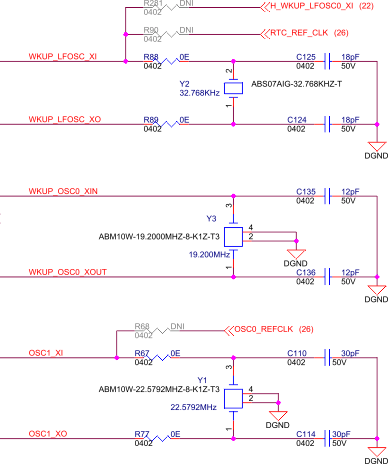SPRUIS4E March 2022 – January 2024
- 1
- Jacinto7 J721E/DRA829/TDA4VM Evaluation Module (EVM)
- Trademarks
- 1Introduction
- 2J721E EVM Overview
- 3EVM User Setup/Configuration
-
4J721E EVM Hardware Architecture
- 4.1 J721E EVM Hardware Top level Diagram
- 4.2 J721E EVM Interface Mapping
- 4.3 I2C Address Mapping
- 4.4 GPIO Mapping
- 4.5 Power Supply
- 4.6 Reset
- 4.7 Clock
- 4.8 Memory Interfaces
- 4.9 MCU Ethernet Interface
- 4.10 QSGMII Ethernet Interface
- 4.11 PCIe Interface
- 4.12 USB Interface
- 4.13 CAN Interface
- 4.14 FPD Interface (Audio Deserializer)
- 4.15 FPD Panel Interface (DSI Video Serializer)
- 4.16 Display Serial Interface (DSI) FPC
- 4.17 Audio Interface
- 4.18 Display Port Interface
- 4.19 MLB Interface
- 4.20 I3C Interface
- 4.21 ADC Interface
- 4.22 RTC Interface
- 4.23 Apple Authentication Header
- 4.24 EVM Expansion Connectors
- 4.25 ENET Expansion Connector
- 4.26 CSI Expansion Connector
- 5Revision History
4.7.1 Processor’s Primary Clock
There are three external crystals attached to the J721E processor to provide the SoC’s Primary clocks WKUP_LFOSC (32 KHz), WKUP_OSC0 (19.2 MHz) and OSC1 (22.5792 MHz) as shown in Figure 4-9.
 Figure 4-9 J721E SoC Primary Clock
Figure 4-9 J721E SoC Primary ClockThe WKUP_OSC0 is required by the processor. Both WKUP_LFOSC and OSC1 are optional clocks (not required for J721E processing). The WKUP_LFOSC can be sourced either on the on-board crystal or from the PMIC. The OSC1 can be sourced from either the on-board crystal or from clock generator (CDCEL937) on the Common Processor board.